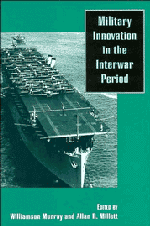Book contents
- Frontmatter
- Contents
- Acknowledgments
- Introduction
- 1 Armored warfare: The British, French, and German experiences
- 2 Assault from the sea: The development of amphibious warfare between the wars – the American, British, and Japanese experiences
- 3 Strategic bombing: The British, American, and German experiences
- 4 Close air support: The German, British, and American experiences, 1918–1941
- 5 Adopting the aircraft carrier: The British, American, and Japanese case studies
- 6 Innovation ignored: The submarine problem – Germany, Britain, and the United States, 1919–1939
- 7 From radio to radar: Interwar military adaptation to technological change in Germany, the United Kingdom, and the United States
- 8 Innovation: Past and future
- 9 Patterns of military innovation in the interwar period
- 10 Military innovation in peacetime
- Index
1 - Armored warfare: The British, French, and German experiences
Published online by Cambridge University Press: 05 August 2012
- Frontmatter
- Contents
- Acknowledgments
- Introduction
- 1 Armored warfare: The British, French, and German experiences
- 2 Assault from the sea: The development of amphibious warfare between the wars – the American, British, and Japanese experiences
- 3 Strategic bombing: The British, American, and German experiences
- 4 Close air support: The German, British, and American experiences, 1918–1941
- 5 Adopting the aircraft carrier: The British, American, and Japanese case studies
- 6 Innovation ignored: The submarine problem – Germany, Britain, and the United States, 1919–1939
- 7 From radio to radar: Interwar military adaptation to technological change in Germany, the United Kingdom, and the United States
- 8 Innovation: Past and future
- 9 Patterns of military innovation in the interwar period
- 10 Military innovation in peacetime
- Index
Summary
Tanks had appeared in large numbers only at the end of the Great War. Their first success had come in the Battle of Cambrai in fall 1917. They had also played a major role in the Australian success at Amiens in early August 1918, a battle that Ludendorff characterized as “the darkest day for the German Army in the war.” Whatever their promise, the performance of those ungainly vehicles in World War I was spotty. A slow, difficult-to-maneuver weapon of war, the armored fighting vehicle of 1917 and 1918 offered its crews minimum vision, maximum discomfort, and general mechanical unreliability.
It was a weapon designed for one simple task: crossing the killing zone between trench lines and breaking into enemy defenses. Neither its developers nor operators had moved beyond that role when the war ended in November 1918. Admittedly, J.F.C. Fuller, at that point working in the War Office, had conceived an ambitious plan, Plan 1919, to use tanks in the next year to attack German headquarters – up to corps level – to paralyze the enemy's command and control. But peace came before the British Army could attempt such an ambitious conception. Consequently, as Europe entered into two decades of peace, the tank, like the airplane, represented a weapon of potential and promise rather than performance on the battlefield.
The rush to judgment in the aftermath of World War II has fundamentally distorted our understanding of the process of innovation in armored warfare in the 1920S and 1930S.
- Type
- Chapter
- Information
- Military Innovation in the Interwar Period , pp. 6 - 49Publisher: Cambridge University PressPrint publication year: 1996
- 9
- Cited by

